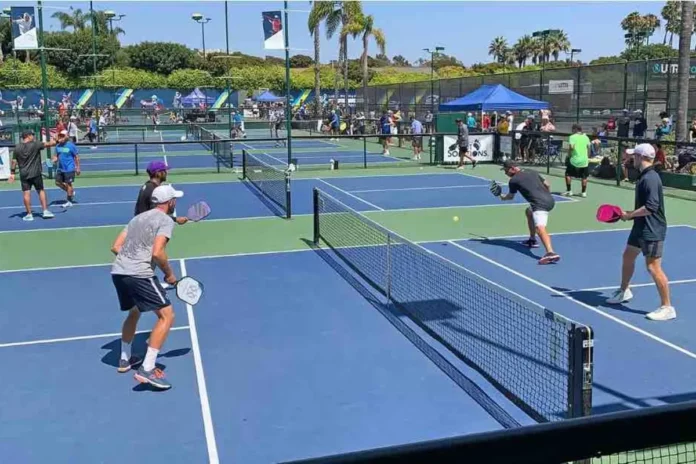Pickleball Kitchen Rules: In pickleball, the kitchen is an important area of the court, and understanding its rules is key for players. A recent family dispute over whether spiking is allowed in the kitchen led to some confusion.
The Kitchen: What Is It?
The kitchen, or non-volley zone, is a seven-foot area on either side of the net. This zone prevents players from dominating the game with fast volleys, encouraging more strategic play.
Without the kitchen, players could easily overpower their opponents with strong shots from the net. The kitchen forces players to focus on pickleball technique and placement, rather than just power.
Can You Spike in the Kitchen?
Yes, you can spike the ball in the kitchen, but only after it bounces. Spiking, which involves hitting the ball forcefully downward, is allowed once the ball has bounced within the kitchen.
However, you are not allowed to spike the ball if it is still in the air before it bounces. This is considered a volley, and volleying in the kitchen is strictly forbidden.
Key Rules About the Kitchen
- No Volleying in the Kitchen: You cannot hit the ball in the air while standing in the kitchen. This means you must be outside the kitchen before hitting a volley.
- Playing the Bounce: You can step into the kitchen to hit a ball that has bounced. After hitting the ball, you may continue into the kitchen. Just remember, no volleying from within the kitchen.
- Kitchen Lines Are In: If any part of your body or equipment touches the kitchen line, you are considered to be in the kitchen.
Legal Spiking in Pickleball
Spiking is an exciting part of pickleball. Once the ball bounces in the kitchen, you are free to step into the area and spike the ball. Keep in mind, however, that spiking on a serve is not allowed, as serves must be underhand and below the waist.
How Spiking and the Kitchen Rule Intersect
You can spike the ball in the kitchen, but only after it bounces. If the ball is still in the air, you must avoid the kitchen to legally perform a volley. The kitchen rule mainly applies to volleys, not spiking after a bounce.
What Happened in the Family Game?
A misunderstanding occurred during a match between a pickleball player and their mother-in-law. After a successful lob shot, the player spiked the ball into the kitchen, leading the mother-in-law to claim, “You can’t spike in the kitchen!”
In reality, the spike was legal because the ball had bounced. This moment served as a reminder to check reliable sources for rules clarification.
Online Misinformation and Rule Clarification
After the incident, the pickleball player searched for clarification but came across an AI-generated article that incorrectly explained the spike rule. This highlighted the importance of consulting official sources like the USA Pickleball Association (USAPA) for accurate rules.
How to Handle Rule Disputes
When disagreements about rules happen, it’s best to keep things lighthearted. Approaching disputes with patience and humor helps maintain the fun of the game. For official rule references, players should rely on credible sources such as the USAPA website.
Legal Spiking After the Bounce
Once the ball bounces in the kitchen, spiking becomes a powerful offensive strategy. This allows for dynamic plays and adds more excitement to the game. Players can use spiking to apply tactical aggression within the non-volley zone.
News in Brief: Pickleball Kitchen Rules
The kitchen rule in pickleball prohibits volleying in the non-volley zone but allows spiking after the ball bounces. A family dispute over the spike rule highlighted the importance of using reliable sources like the USAPA for accurate pickleball rules.
ALSO READ: The Kitchen in Pickleball: Rules Overview

